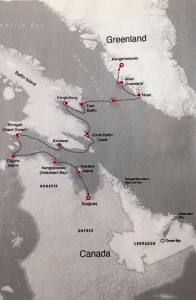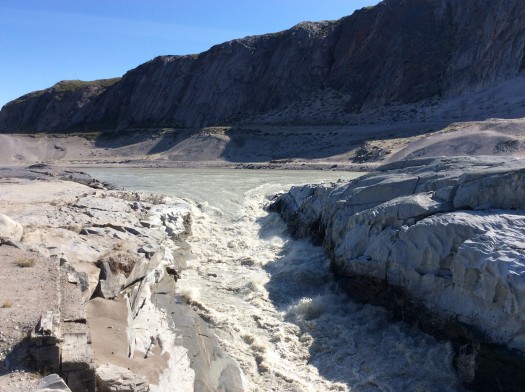A Placemaking Journal
Kangerlussuaq: Heart of the Arctic Day 13
Wednesday, July 29, 2015
After sailing up one of the longest fjords in the world, the delightfully scenic Söndre Strömfjord, we disembarked Ocean Endeavour for the last time, to explore the community of Kangerlussuaq. One group went off for a walk on the ice cap and the other on a nature hike, before we flew out of Greenland midafternoon. We headed for Toronto, stopping in Goose Bay, Labrador, to refuel. Tomorrow, we’ll disburse to Japan, New Zealand, Australia, Great Britain, Israel, across the US and Canada.
Greenland creates its own high pressure ridge, because it’s such a massive island with a thick icecap. Most weather systems go around this dome of pressure, which is why the desert island gets only 5 to 10 inches of rain each year.
Strong ocean currents keep most of the 168-kilometre long Söndre Strömfjord and this part of the Arctic Ocean navigable year round. This comparatively mild weather makes Kangerlussuaq a strong whaling and fishing community. It also attracted the US to build a air base here in WWII, along with the handy proximity to Europe.
Local infrastructure is beefy, including a 2.8 kilometres long airstrip, hearkening back to the U.S. presence, which ended with the Cold War, in 1992. Telephone poles to nowhere are an eerie reminder of change, along with what is now Greenland’s main international airport.
Our local tour guide pointed out notable changes since he moved here from Denmark in 2006, when the willows averaged 0.3 meters tall, but now they average 1.6 meters, thanks to the warming weather and extended growing season. During that timeframe, the wall of the icecap has pulled back between 30 and 40 metres, making the glacier-fed river so fast-moving that additional drainage and bridges were necessary for the roadways to stay functional. This roadwork swallowed up a backhoe, buried under the silt never to be seen again.
Hunting season for the caribou starts August 1, so our eyes were peeled for them along with Arctic hare, muskox, and birds. However, even though this region is usually distinguished by rich biodiversity, we only saw arctic hare and birds, including a wheatear, a bird that migrates around Greenland, then across Europe to Africa.
Even now in late July, it’s starting to trend colder, and the water levels are starting to fall in the rivers as the icecap cools. A local saying predicts that the 6th of September will see snow on the mountain. But it’s usually melted by afternoon.
The permafrost here starts at 1 meter under the ground’s surface, and is frozen solid for 20 meters deep (3 to 60 feet). But summers are sunny on this desert island. Lake Ferguson supplies the freshwater here for the 550 year-round residents.
While I will revisit last Arctic insights sometime soon, this ends our 13 days at sea and the daily log portion of my Heart of the Arctic Series. It’s a bit poignant to say goodbye. It’d be tough to come to the Arctic and not be moved, but somehow the people on board made the experience more lasting. The group spanned from a 10-year old to an 85-year old, with several lasting friendships made.
The Adventure Canada “floating university” sort of experience certainly was a big part of it, but it was more than that. Our expedition leaders, Matthew James Bradley-Swan and Stefan Kindberg have been at it for 22 years, building relationships with northern communities, and are well able to weave environmental impacts, history, geology, and poetry into the experience.
Our host, Dave Freeze, and musician, Thom Kovacs, brought laughter and adventure. Together, with a large expedition staff, they all are great connectors of people to places. So in a way that’s completely different than we usually contemplate here, they certainly are placeshakers.
To read the entire Heart of the Arctic series, go here.
–Hazel Borys
If PlaceShakers is our soapbox, our Facebook page is where we step down, grab a drink and enjoy a little conversation. Looking for a heads-up on the latest community-building news and perspective from around the web? Click through and “Like” us and we’ll keep you in the loop.











